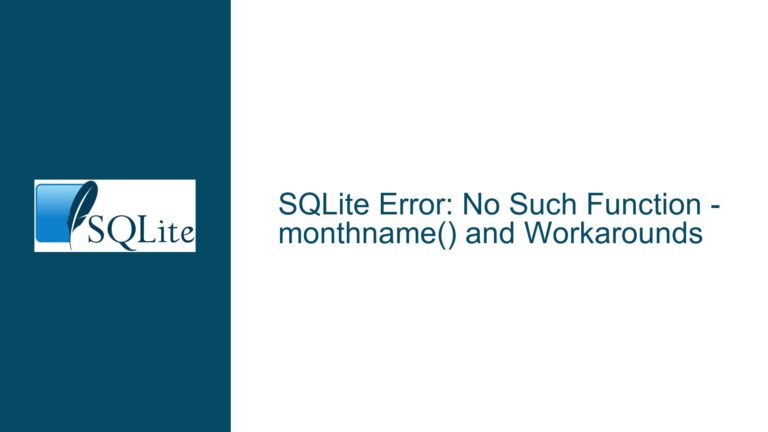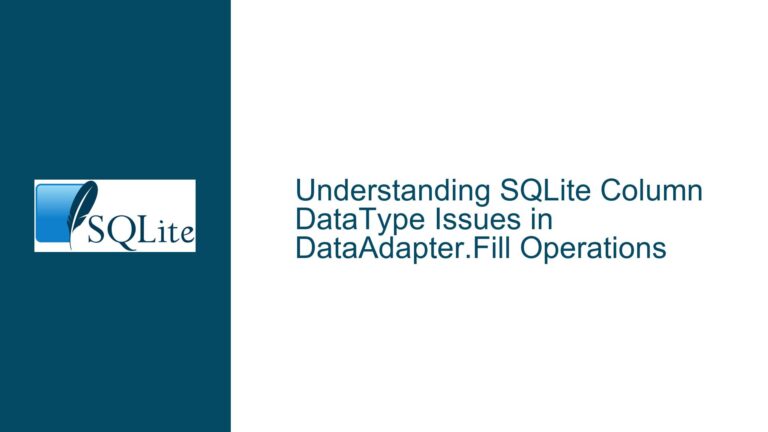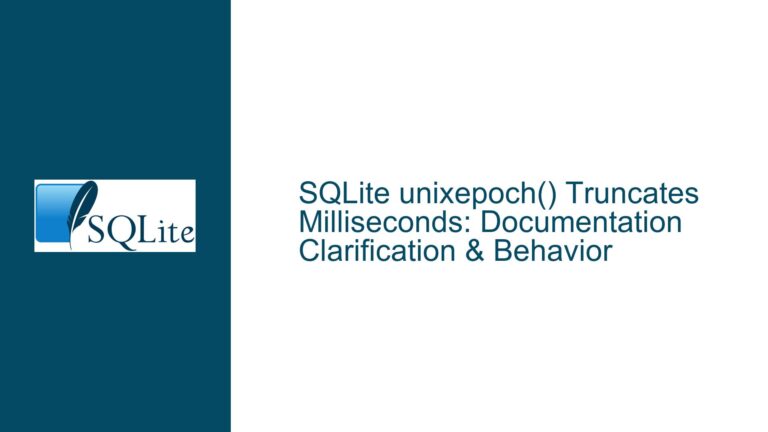Forcing SELECT * on Virtual Tables to Return HIDDEN Columns in SQLite
SQLite Virtual Tables and HIDDEN Columns Behavior
SQLite virtual tables are a powerful feature that allows developers to define custom table-like structures backed by application-specific logic. These tables can include HIDDEN columns, which are not returned by default when a SELECT * query is executed. HIDDEN columns are typically used for metadata or internal identifiers that are not part of the logical data model but are necessary for certain operations, such as filtering or joining.
In the context of the provided example, a virtual table named file is defined with the following schema:
CREATE TABLE file(
`path` TEXT,
`directory` TEXT,
`filename` TEXT,
`inode` BIGINT,
`file_id` TEXT HIDDEN
);
Here, file_id is marked as HIDDEN, meaning it will not be included in the result set of a SELECT * query unless explicitly referenced in the query. For instance:
SELECT * FROM file WHERE path = '/home/me/file.txt';
This query will return only the path, directory, filename, and inode columns, excluding file_id. However, the goal is to have file_id included in the result set when it is used in a predicate, such as:
SELECT * FROM file WHERE file_id = N;
This behavior is not natively supported by SQLite, as HIDDEN columns are intentionally excluded from SELECT * results. This limitation raises the question of how to achieve the desired functionality without compromising the DRY (Don’t Repeat Yourself) principle or resorting to repetitive query patterns.
Challenges with HIDDEN Columns and SELECT * Queries
The core challenge lies in the design and implementation of SQLite’s virtual tables and the behavior of HIDDEN columns. HIDDEN columns are intended to be excluded from the default result set of SELECT * queries to avoid cluttering the output with internal or metadata fields. However, this design choice can create complications when these columns are needed for filtering or other operations.
One possible cause of this issue is the way SQLite’s query planner and virtual table module interact. When a SELECT * query is executed, the virtual table module is responsible for determining which columns to return. Since HIDDEN columns are not part of the logical schema, they are excluded by default. This exclusion is hardcoded into SQLite’s behavior and cannot be overridden without modifying the virtual table implementation.
Another factor is the lack of a built-in mechanism to conditionally include HIDDEN columns based on their usage in predicates. SQLite does not provide a way to dynamically alter the result set of a SELECT * query based on the presence of a HIDDEN column in the WHERE clause. This limitation forces developers to either explicitly reference the HIDDEN column in the query or use alternative approaches, such as views or application-level logic, to achieve the desired behavior.
Implementing Views and Custom Query Logic
To address the challenge of including HIDDEN columns in SELECT * queries, developers can leverage SQLite’s support for views and custom query logic. A view is a virtual table that is defined by a query, allowing developers to encapsulate complex logic and provide a simplified interface for querying data. By creating a view that explicitly includes the HIDDEN column, developers can achieve the desired behavior without modifying the underlying virtual table.
For example, consider the following view definition:
CREATE VIEW filelist AS
SELECT *, file_id FROM file;
This view includes all columns from the file table, including the HIDDEN file_id column. Queries against this view will return the file_id column by default, regardless of whether it is referenced in the WHERE clause. For instance:
SELECT * FROM filelist WHERE path = '/home/me/file.txt';
This query will return the path, directory, filename, inode, and file_id columns, achieving the desired behavior. Similarly, queries that filter by file_id will also include the column in the result set:
SELECT * FROM filelist WHERE file_id = N;
While views provide a straightforward solution, they come with some trade-offs. Views are read-only by default, meaning that any modifications to the data must be performed on the underlying table. Additionally, views can introduce performance overhead, particularly if they involve complex joins or aggregations. However, in the context of virtual tables, these trade-offs are often acceptable, as the primary goal is to provide a consistent and convenient interface for querying data.
Another approach is to implement custom query logic at the application level. By intercepting and modifying queries before they are executed, developers can dynamically include HIDDEN columns based on their usage in predicates. This approach requires a deep understanding of SQLite’s query parsing and execution process, as well as careful handling of edge cases and potential performance implications. However, it provides the most flexibility and control over the behavior of SELECT * queries.
For example, an application could parse incoming queries and rewrite them to explicitly include HIDDEN columns when they are referenced in the WHERE clause. This approach would require a custom query parser and rewriter, as well as integration with the virtual table module to ensure consistent behavior. While this solution is more complex than using views, it allows developers to achieve the desired behavior without modifying the underlying virtual table or relying on external tools.
Advanced Techniques: Custom Virtual Table Modules
For developers with advanced needs, creating a custom virtual table module provides the ultimate level of control over the behavior of SELECT * queries and HIDDEN columns. SQLite’s virtual table API allows developers to define custom table implementations that can override default behaviors and implement advanced features. By creating a custom virtual table module, developers can implement logic to conditionally include HIDDEN columns in the result set based on their usage in predicates.
The process of creating a custom virtual table module involves defining a set of callback functions that SQLite will call to perform operations such as query planning, row iteration, and column access. These functions can be implemented to inspect the query and dynamically adjust the result set based on the presence of HIDDEN columns in the WHERE clause. For example, the xBestIndex function can be used to analyze the query and determine which columns are referenced in predicates, while the xColumn function can be used to conditionally include HIDDEN columns in the result set.
Implementing a custom virtual table module requires a deep understanding of SQLite’s internal architecture and the virtual table API. It also involves significant development effort, as the module must handle a wide range of query patterns and edge cases. However, for applications with complex requirements or performance constraints, this approach provides the most flexibility and control over the behavior of virtual tables and HIDDEN columns.
Performance Considerations and Best Practices
When working with virtual tables and HIDDEN columns, performance is a critical consideration. The inclusion of additional columns in the result set can increase the amount of data transferred between the database and the application, potentially impacting query performance. Additionally, the use of views or custom query logic can introduce overhead, particularly for large datasets or complex queries.
To mitigate these performance concerns, developers should carefully evaluate the trade-offs between convenience and efficiency. Views should be used judiciously, and their impact on query performance should be measured and optimized. Custom query logic should be implemented with performance in mind, avoiding unnecessary parsing or rewriting of queries. When creating custom virtual table modules, developers should focus on optimizing the implementation of key functions, such as xBestIndex and xColumn, to minimize overhead and ensure efficient query execution.
In addition to performance considerations, developers should follow best practices for working with virtual tables and HIDDEN columns. These include:
- Consistent Naming Conventions: Use clear and consistent naming conventions for HIDDEN columns to avoid confusion and ensure that their purpose is easily understood.
- Documentation: Document the behavior of HIDDEN columns and any custom logic or views that are used to include them in
SELECT *queries. This documentation should be accessible to all developers working on the project. - Testing: Thoroughly test the behavior of virtual tables and HIDDEN columns, including edge cases and performance scenarios. Automated tests should be used to ensure consistent behavior across different query patterns and datasets.
- Maintenance: Regularly review and update the implementation of virtual tables and HIDDEN columns to address any issues or changes in requirements. This includes monitoring performance and making adjustments as needed.
By following these best practices, developers can ensure that their use of virtual tables and HIDDEN columns is both effective and efficient, providing a robust and maintainable solution for managing complex data structures in SQLite.
Conclusion
The challenge of including HIDDEN columns in SELECT * queries on SQLite virtual tables highlights the flexibility and complexity of SQLite’s virtual table mechanism. While the default behavior of excluding HIDDEN columns from SELECT * results is intentional, it can create complications for developers who need to include these columns based on their usage in predicates. By leveraging views, custom query logic, or custom virtual table modules, developers can achieve the desired behavior while adhering to the DRY principle and maintaining performance and maintainability.
Each approach has its trade-offs, and the choice of solution depends on the specific requirements and constraints of the application. Views provide a simple and effective solution for many use cases, while custom query logic and virtual table modules offer greater flexibility and control for advanced scenarios. By carefully evaluating these options and following best practices, developers can effectively manage HIDDEN columns in SQLite virtual tables and ensure that their applications are both powerful and efficient.






